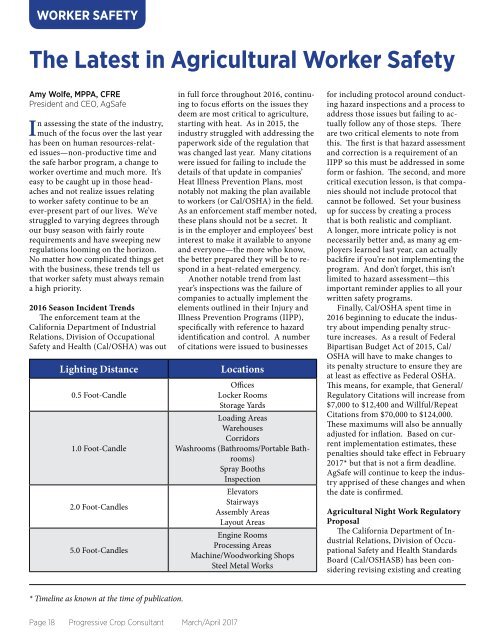Mar_Apr_PCC_2017_Web
Create successful ePaper yourself
Turn your PDF publications into a flip-book with our unique Google optimized e-Paper software.
WORKER SAFETY<br />
The Latest in Agricultural Worker Safety<br />
Amy Wolfe, MPPA, CFRE<br />
President and CEO, AgSafe<br />
In assessing the state of the industry,<br />
much of the focus over the last year<br />
has been on human resources-related<br />
issues—non-productive time and<br />
the safe harbor program, a change to<br />
worker overtime and much more. It’s<br />
easy to be caught up in those headaches<br />
and not realize issues relating<br />
to worker safety continue to be an<br />
ever-present part of our lives. We’ve<br />
struggled to varying degrees through<br />
our busy season with fairly route<br />
requirements and have sweeping new<br />
regulations looming on the horizon.<br />
No matter how complicated things get<br />
with the business, these trends tell us<br />
that worker safety must always remain<br />
a high priority.<br />
2016 Season Incident Trends<br />
The enforcement team at the<br />
California Department of Industrial<br />
Relations, Division of Occupational<br />
Safety and Health (Cal/OSHA) was out<br />
Lighting Distance<br />
0.5 Foot-Candle<br />
1.0 Foot-Candle<br />
2.0 Foot-Candles<br />
5.0 Foot-Candles<br />
in full force throughout 2016, continuing<br />
to focus efforts on the issues they<br />
deem are most critical to agriculture,<br />
starting with heat. As in 2015, the<br />
industry struggled with addressing the<br />
paperwork side of the regulation that<br />
was changed last year. Many citations<br />
were issued for failing to include the<br />
details of that update in companies’<br />
Heat Illness Prevention Plans, most<br />
notably not making the plan available<br />
to workers (or Cal/OSHA) in the field.<br />
As an enforcement staff member noted,<br />
these plans should not be a secret. It<br />
is in the employer and employees’ best<br />
interest to make it available to anyone<br />
and everyone—the more who know,<br />
the better prepared they will be to respond<br />
in a heat-related emergency.<br />
Another notable trend from last<br />
year’s inspections was the failure of<br />
companies to actually implement the<br />
elements outlined in their Injury and<br />
Illness Prevention Programs (IIPP),<br />
specifically with reference to hazard<br />
identification and control. A number<br />
of citations were issued to businesses<br />
Locations<br />
Offices<br />
Locker Rooms<br />
Storage Yards<br />
Loading Areas<br />
Warehouses<br />
Corridors<br />
Washrooms (Bathrooms/Portable Bathrooms)<br />
Spray Booths<br />
Inspection<br />
Elevators<br />
Stairways<br />
Assembly Areas<br />
Layout Areas<br />
Engine Rooms<br />
Processing Areas<br />
Machine/Woodworking Shops<br />
Steel Metal Works<br />
for including protocol around conducting<br />
hazard inspections and a process to<br />
address those issues but failing to actually<br />
follow any of those steps. There<br />
are two critical elements to note from<br />
this. The first is that hazard assessment<br />
and correction is a requirement of an<br />
IIPP so this must be addressed in some<br />
form or fashion. The second, and more<br />
critical execution lesson, is that companies<br />
should not include protocol that<br />
cannot be followed. Set your business<br />
up for success by creating a process<br />
that is both realistic and compliant.<br />
A longer, more intricate policy is not<br />
necessarily better and, as many ag employers<br />
learned last year, can actually<br />
backfire if you’re not implementing the<br />
program. And don’t forget, this isn’t<br />
limited to hazard assessment—this<br />
important reminder applies to all your<br />
written safety programs.<br />
Finally, Cal/OSHA spent time in<br />
2016 beginning to educate the industry<br />
about impending penalty structure<br />
increases. As a result of Federal<br />
Bipartisan Budget Act of 2015, Cal/<br />
OSHA will have to make changes to<br />
its penalty structure to ensure they are<br />
at least as effective as Federal OSHA.<br />
This means, for example, that General/<br />
Regulatory Citations will increase from<br />
$7,000 to $12,400 and Willful/Repeat<br />
Citations from $70,000 to $124,000.<br />
These maximums will also be annually<br />
adjusted for inflation. Based on current<br />
implementation estimates, these<br />
penalties should take effect in February<br />
<strong>2017</strong>* but that is not a firm deadline.<br />
AgSafe will continue to keep the industry<br />
apprised of these changes and when<br />
the date is confirmed.<br />
Agricultural Night Work Regulatory<br />
Proposal<br />
The California Department of Industrial<br />
Relations, Division of Occupational<br />
Safety and Health Standards<br />
Board (Cal/OSHASB) has been considering<br />
revising existing and creating<br />
* Timeline as known at the time of publication.<br />
Page 18 Progressive Crop Consultant <strong>Mar</strong>ch/<strong>Apr</strong>il <strong>2017</strong>


















